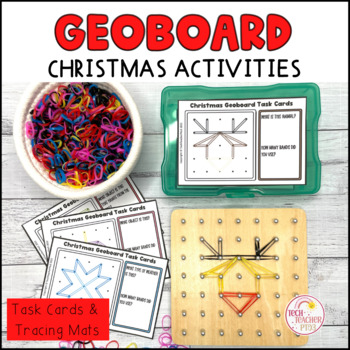Geoboard Activities Christmas Task Cards and Tracing Worksheets
- PDF
Also included in
- These geoboard activities will allow your students to explore basic concepts of plane geometry such as perimeter, area and the characteristics of basic shapes. Let students recreate the pictures on their own geoboard with the task cards or use the printable tracing worksheets in your next math lessoPrice $12.25Original Price $17.50Save $5.25
Description
These geoboard activities will allow your students to explore basic concepts of plane geometry such as perimeter, area and the characteristics of basic shapes. Let students recreate the Christmas pictures on their own geoboard with the task cards or use the printable tracing worksheets in your next math lesson.
Each task card asks students to name the picture and count how many elastics they have used to create it. Worksheets ask students to copy the picture into the box next to it using the same reference points.
SAVE 30% by buying ALL of my other Geoboard Resources in 1 Bundle!
Included in this pack you will find the following activities:
- 12 colour tasks cards with a Christmas theme
- 12 colour printable worksheets to laminate and use with a whiteboard marker
- Answer key
*********************************************************************
ALIGNED WITH THE FOLLOWING CURRICULUMS
COMMON CORE
Kindergarten Math
Analyze, compare, create, and compose shapes.
CCSS.MATH.CONTENT.K.G.B.4
Analyze and compare two- and three-dimensional shapes, in different sizes and orientations, using informal language to describe their similarities, differences, parts (e.g., number of sides and vertices/"corners") and other attributes (e.g., having sides of equal length).
CCSS.MATH.CONTENT.K.G.B.5
Model shapes in the world by building shapes from components (e.g., sticks and clay balls) and drawing shapes.
CCSS.MATH.CONTENT.K.G.B.6
Compose simple shapes to form larger shapes. For example, "Can you join these two triangles with full sides touching to make a rectangle?"
AUSTRALIAN CURRICULUM.
Foundation Year Maths
Recognise and classify familiar two-dimensional shapes and three-dimensional objects using obvious features (ACMMG022)
*********************************************************************
☀☀☀☀STAY CONNECTED TO TECH TEACHER PTO3☀☀☀☀
❤️ Follow Me to find out when new products are added ❤️
********************************************************************
Customer Tips:
How to get TPT credit to use on future purchases:
• Please go to your My Purchases page (you may need to login). Beside each purchase you'll see a Provide Feedback button. Simply click it and you will be taken to a page where you can give a quick rating and leave a short comment for the product. Each time you give feedback, TPT gives you feedback credits that you use to lower the cost of your future purchases. I value your feedback greatly as it helps me determine which products are most valuable for your classroom so I can create more for you. ☺
Be the first to know about my new discounts, freebies and product launches:
• Look for the green star next to my store logo and click it to become a follower. Voila! You will now receive email updates about this store. ☺
***************************************************************






